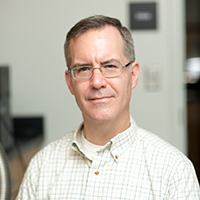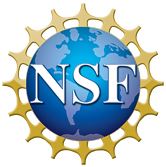- Home
- What We Do
- Laboratory Immersions
- Immersions 2019
- Imm2019Trinity_GravWaves
Principles of Gravitational-Wave Detection
Trinity University, June 5-7, 2019
The Immersion consists of four activities. The first two demonstrate how “folding” an arm of the interferometer (i.e., causing the light to bounce back and forth multiple times) improves sensitivity to changes in distance. Participants will construct a Herriott delay line, followed by a Fabry-Perot optical cavity, and observe how each responds to the motion of a mirror. The third activity provides an analogy to gravitational-wave detection by having the participants detect sound waves from a loudspeaker. Finally, participants will use phase modulation and the technique of heterodyning to “lock” the optical cavity arm to a resonant condition, so that the laser forms a standing wave in the cavity.
While each activity will have a slightly different setup, the general apparatus is shown below. A HeNe laser (1) is aligned onto a beamsplitter (2). The two resulting beams travel in perpendicular directions, reflect off mirrors (3b and 4), and interfere at the beamsplitter. The resulting interference pattern is detected by a photodiode (7). So far this is the basic Michelson interferometer setup. The major difference is a partially-transmissive optic inserted at (3a), creating an optical cavity in one arm.

The schedule of activities is as follows:
Day 1 Morning – Alignment of basic Michelson, demonstration of delay line
Day 1 Afternoon – Characterizing the optical cavity arm
Day 2 Morning – Detecting sound waves
Day 2 Afternoon – Locking the optical cavity to resonance
Day 3 Morning – Bonus activity: turning an interferometer into a wavelength meter (in which participants will learn how a similar setup can measure the wavelength of a laser to a precision of 0.1 nanometers)
Participants will learn the principles of interference, interferometry, and gravitational-wave detection. They will gain experience in aligning the interferometer, measuring signals with photodiode and oscilloscope, and using basic electronic circuits to create a feedback loop for optical cavity control. Most importantly, participants will be able to introduce their students to the new, growing field of gravitational-wave astronomy.
Participants should prepare themselves by learning about interference and the Michelson-Morley experiment, and by reading an American Journal of Physics paper on the lab activities that will be provided. Participants should feel free to bring whatever notebooks or electronic devices they would like for taking notes and photos. All necessary equipment will be provided. We will be using a Class IIIA helium-neon laser, and participants will be alerted to necessary safety precautions.
The cost of the LIGO analogy lab setups is approximately $3,300 plus optical table. The bonus activity adds another $1,500, but most of that is for a PASCO 850 Interface, common in many high school and college teaching labs, and any substitute analog-to-digital converter would also work.
 Host and Mentor:
Host and Mentor:
Dennis Ugolini earned his BS in Physics from Caltech and his PhD from Stanford University, working on physics of the eta meson under Nobel Laureate Martin Perl. He then switched fields from particles to gravitational wave interferometry, first as a postdoctoral researcher at the Caltech 40-Meter Prototype Laboratory and then as a faculty member at Trinity University. He has been a member of the LIGO Scientific Collaboration for 19 years, working on characterizing and eliminating the noise contribution from mobile surface charge on LIGO optics. Along with Dr. Antje Bergmann of the Karlsruhe Institute of Technology, he developed the LIGO analogy experiments used in this laboratory immersion.
Dennis Ugolini, Professor and Department Chair, Department of Physics and Astronomy, Trinity University, One Trinity Place, San Antonio, TX 78212. Email: dugolini@trinity.edu. Phone: (210) 999-7890.
Please note that the Jonathan F. Reichert Foundation has established a grant program to help purchase apparatus used in Laboratory Immersions. Limitations and exclusions apply, but generally speaking the foundation may support up to 40% of the cost of the required equipment. FPGAs are likely excluded; however, apparatus controlled by an FPGA might be supported.





